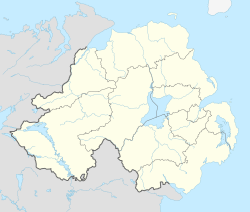Belfast metropolitan area facts for kids
Quick facts for kids
Belfast Metropolitan Area
|
|
|---|---|
|
Metropolitan area
|
|
| Sovereign State | United Kingdom |
| Constituent Country | Northern Ireland |
| District | |
| County | County Antrim / County Down |
| Area | |
| • Total | 370 sq mi (960 km2) |
| Time zone | UTC+0 (GMT) |
| • Summer (DST) | UTC-1 (BST (WEST)) |
| Area code(s) | 028 |
The Belfast metropolitan area, also known as Greater Belfast, is a large group of towns and cities around Belfast, Northern Ireland. It includes many commuter towns and areas that have grown outwards from Belfast. In 2011, about 672,522 people lived here. This means over a third of Northern Ireland's population lives in this area!
Contents
What is the Belfast Metropolitan Area?
This area was first officially recognized in the late 1990s. The British government wanted a clear plan for the Belfast Region. Six local government districts were chosen as the main parts of this metropolitan area. These districts are Belfast, Castlereagh, Carrickfergus, Lisburn, Newtownabbey, and North Down.
Understanding the Urban Area
The Belfast Metropolitan Urban Area is the continuous built-up part within these six districts. This means it's where buildings and towns connect without much open space in between. In 2001, about 579,276 people lived in this urban area.
Important Towns in Greater Belfast
The Greater Belfast area includes many towns that have been around for a long time. Some of these are Carrickfergus, Bangor, Lisburn, and Holywood. Many of these towns were important even before Belfast became a big city. For example, Carrickfergus was once the main city in the northern part of Ireland during Norman times. Bangor was a very important center for learning and Christianity way back in 555 AD. Even though Lisburn is now a city, it is still part of this larger metropolitan area.
Towns and Their Populations
Here is a list of the main urban areas within the Belfast metropolitan area and their populations from the 2001 Census.
| Rank | Urban Area | Population
(2001 Census) |
|---|---|---|
| 1 | Belfast urban area | 276,605 |
| 2 | Lisburn urban area | 71,403 |
| 3 | Newtownabbey urban area | 62,022 |
| 4 | Bangor | 58,368 |
| 5 | Castlereagh urban area | 54,636 |
| 6 | Carrickfergus | 27,192 |
| 7 | Holywood urban area | 12,027 |
| 8 | Carryduff | 6,564 |
| 9 | Greenisland | 5,067 |
| 10 | Groomsport & Crawfordsburn | 1,401 |
| 11 | Helen's Bay | 1,356 |
| 12 | Milltown | 1,356 |
| 13 | Seahill | 1,179 |
| Total | Belfast metropolitan urban area | 579,276 |
Facts from the 2001 Census
A census is like a big survey that counts everyone and collects information about them. The 2001 census showed some interesting facts about the people living in the Belfast metropolitan urban area:
- About 22% of the people were under 16 years old.
- About 19.2% of the people were 60 years old or older.
- The population was 47.4% male and 52.6% female.
- About 40.5% of people said they were from a Catholic background.
- About 55.5% of people said they were from a Protestant background.
- About 4.3% of people aged 16–74 were unemployed.
Population Maps
These maps show how people were spread out in the Belfast metropolitan area during the 2011 UK Census. They also show information about religion, national identity, and people born outside the UK and Ireland.
-
.
Population density
-
.
Percentage who were Catholic or brought up Catholic
-
.
Most commonly stated national identity
-
.
Percentage born outside the UK and the Republic of Ireland


